Risk Management Assessment - Finance Broking, Semester 1
VerifiedAdded on 2022/08/20
|10
|2573
|14
Homework Assignment
AI Summary
This document presents a comprehensive risk management assessment completed by a student, covering various aspects of financial risk. The assessment begins with written activities that define risk categories, the risk management process, and credit risk considerations. A project component requires the identification and explanation of risks impacting a finance broking business, including stakeholders and an understanding of the Australian Standard AS/NZS ISO 31000:2009. Case studies are then utilized to analyze specific scenarios, such as a new client seeking a loan and a credit assessment for a loan application. The assessment includes risk registers, action plans, and the evaluation of risk likelihood and consequence to determine risk ratings. The student analyzes various risks, including default risk, governmental risk, and security risk, and develops preventative and corrective actions to mitigate them.

Risk Management Assessment
Assessment cover sheet
In order for your assessment to be marked, you must complete and upload all tasks
and this cover sheet via the AAMC Training Group portal. Your assessment tasks must
be uploaded in an electronic format i.e., Word, Excel, PDF, or Scan. A maximum of five (5)
attachments (maximum 20MB each) can be uploaded for this assessment. Please see the
step-by-step instructions in your Member Area on how to upload assessments.
Student details
Course name
Assessment name Risk Management Assessment
Surname Given name
Address Postcode
Email
Phone Phone (other)
Current occupation
Industry Years in industry
When you upload your assessment, you will be asked to confirm that your assessment
submission to AAMC Training is your work and NOT the result of plagiarism or excessive
collaboration and that all material used from any third party has been identified and
referenced appropriately. AAMC Training may conduct independent evaluation checks and
contact your supervisor to discuss your assessment.
Checklist of attachments:
☐ Task 1 – Written activities
☐ Task 2 – Project
☐ Task 3 – Case study 1
☐ Task 4 – Report
☐ Task 5 – Case Study 2
Please indicate the style of course undertaken:
☐ Face to face Trainer’s name:
☐ Correspondence ☐ Online
Once your assessment has been uploaded, it will be pending review with your nominated
course assessor and marked within 5-10 working days. You will receive an email advising you
have been marked as "satisfactory" or "additional information required."
If you have queries relating specifically to your assessment, please log an 'Assessment Query’
under the HELP tab on your Members Area dashboard, and a Student Support officer will
respond. Alternatively, if you have an administration query, please go to 'Admin Query.' For
example, I am having trouble with uploading my assessments and require assistance – can
you please help me with this?
Should you need to speak to someone during office hours, please contact us by:
Phone: +61 (03) 9391 3643 / +61 (0)8 9344 4088 OR Email: info@aamctraining.edu.au
Assessment V3.0 © AAMC Training Group A1
Assessment cover sheet
In order for your assessment to be marked, you must complete and upload all tasks
and this cover sheet via the AAMC Training Group portal. Your assessment tasks must
be uploaded in an electronic format i.e., Word, Excel, PDF, or Scan. A maximum of five (5)
attachments (maximum 20MB each) can be uploaded for this assessment. Please see the
step-by-step instructions in your Member Area on how to upload assessments.
Student details
Course name
Assessment name Risk Management Assessment
Surname Given name
Address Postcode
Phone Phone (other)
Current occupation
Industry Years in industry
When you upload your assessment, you will be asked to confirm that your assessment
submission to AAMC Training is your work and NOT the result of plagiarism or excessive
collaboration and that all material used from any third party has been identified and
referenced appropriately. AAMC Training may conduct independent evaluation checks and
contact your supervisor to discuss your assessment.
Checklist of attachments:
☐ Task 1 – Written activities
☐ Task 2 – Project
☐ Task 3 – Case study 1
☐ Task 4 – Report
☐ Task 5 – Case Study 2
Please indicate the style of course undertaken:
☐ Face to face Trainer’s name:
☐ Correspondence ☐ Online
Once your assessment has been uploaded, it will be pending review with your nominated
course assessor and marked within 5-10 working days. You will receive an email advising you
have been marked as "satisfactory" or "additional information required."
If you have queries relating specifically to your assessment, please log an 'Assessment Query’
under the HELP tab on your Members Area dashboard, and a Student Support officer will
respond. Alternatively, if you have an administration query, please go to 'Admin Query.' For
example, I am having trouble with uploading my assessments and require assistance – can
you please help me with this?
Should you need to speak to someone during office hours, please contact us by:
Phone: +61 (03) 9391 3643 / +61 (0)8 9344 4088 OR Email: info@aamctraining.edu.au
Assessment V3.0 © AAMC Training Group A1
Paraphrase This Document
Need a fresh take? Get an instant paraphrase of this document with our AI Paraphraser
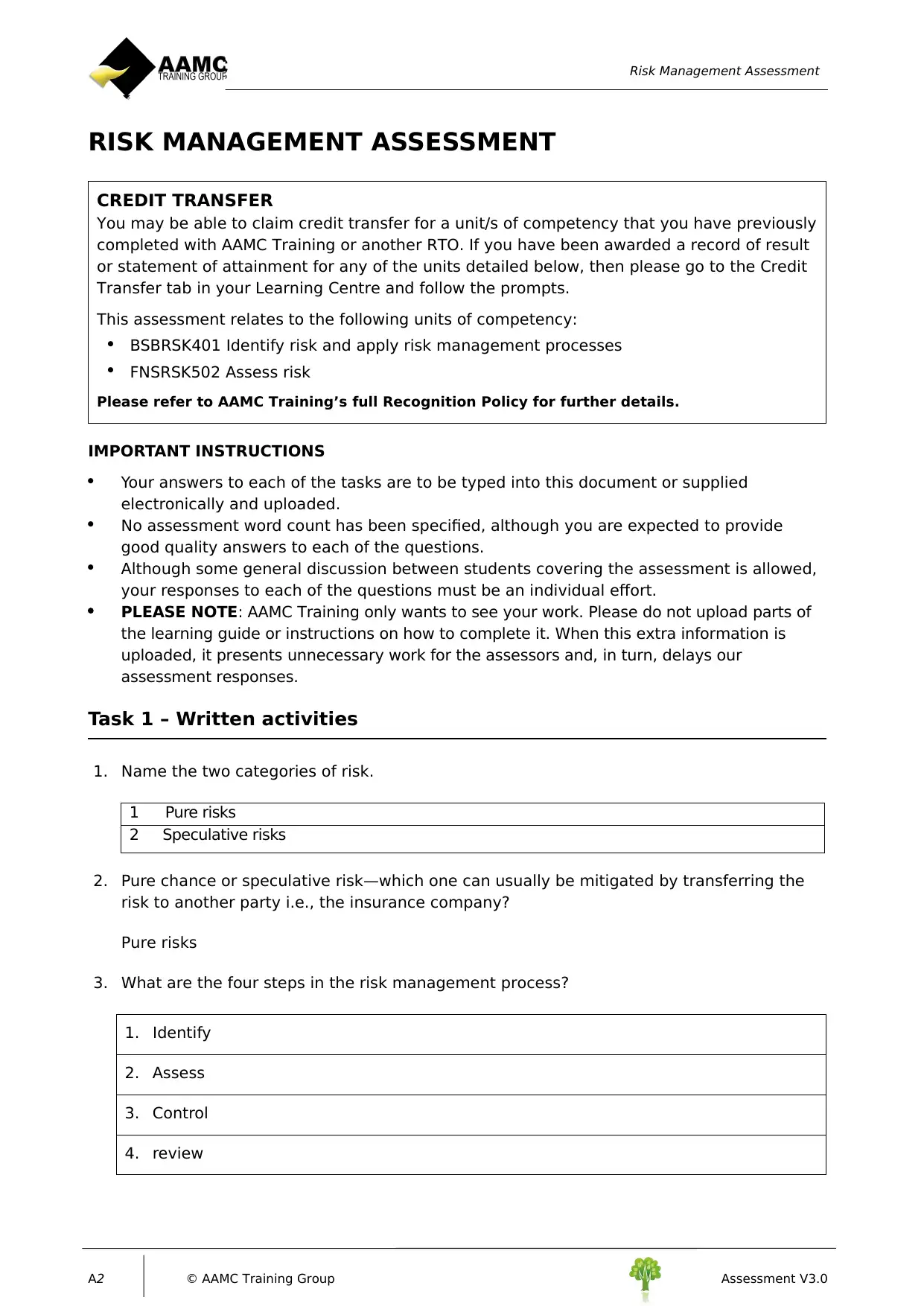
Risk Management Assessment
RISK MANAGEMENT ASSESSMENT
CREDIT TRANSFER
You may be able to claim credit transfer for a unit/s of competency that you have previously
completed with AAMC Training or another RTO. If you have been awarded a record of result
or statement of attainment for any of the units detailed below, then please go to the Credit
Transfer tab in your Learning Centre and follow the prompts.
This assessment relates to the following units of competency:
BSBRSK401 Identify risk and apply risk management processes
FNSRSK502 Assess risk
Please refer to AAMC Training’s full Recognition Policy for further details.
IMPORTANT INSTRUCTIONS
Your answers to each of the tasks are to be typed into this document or supplied
electronically and uploaded.
No assessment word count has been specified, although you are expected to provide
good quality answers to each of the questions.
Although some general discussion between students covering the assessment is allowed,
your responses to each of the questions must be an individual effort.
PLEASE NOTE: AAMC Training only wants to see your work. Please do not upload parts of
the learning guide or instructions on how to complete it. When this extra information is
uploaded, it presents unnecessary work for the assessors and, in turn, delays our
assessment responses.
Task 1 – Written activities
1. Name the two categories of risk.
1 Pure risks
2 Speculative risks
2. Pure chance or speculative risk—which one can usually be mitigated by transferring the
risk to another party i.e., the insurance company?
Pure risks
3. What are the four steps in the risk management process?
1. Identify
2. Assess
3. Control
4. review
A2 © AAMC Training Group Assessment V3.0
RISK MANAGEMENT ASSESSMENT
CREDIT TRANSFER
You may be able to claim credit transfer for a unit/s of competency that you have previously
completed with AAMC Training or another RTO. If you have been awarded a record of result
or statement of attainment for any of the units detailed below, then please go to the Credit
Transfer tab in your Learning Centre and follow the prompts.
This assessment relates to the following units of competency:
BSBRSK401 Identify risk and apply risk management processes
FNSRSK502 Assess risk
Please refer to AAMC Training’s full Recognition Policy for further details.
IMPORTANT INSTRUCTIONS
Your answers to each of the tasks are to be typed into this document or supplied
electronically and uploaded.
No assessment word count has been specified, although you are expected to provide
good quality answers to each of the questions.
Although some general discussion between students covering the assessment is allowed,
your responses to each of the questions must be an individual effort.
PLEASE NOTE: AAMC Training only wants to see your work. Please do not upload parts of
the learning guide or instructions on how to complete it. When this extra information is
uploaded, it presents unnecessary work for the assessors and, in turn, delays our
assessment responses.
Task 1 – Written activities
1. Name the two categories of risk.
1 Pure risks
2 Speculative risks
2. Pure chance or speculative risk—which one can usually be mitigated by transferring the
risk to another party i.e., the insurance company?
Pure risks
3. What are the four steps in the risk management process?
1. Identify
2. Assess
3. Control
4. review
A2 © AAMC Training Group Assessment V3.0
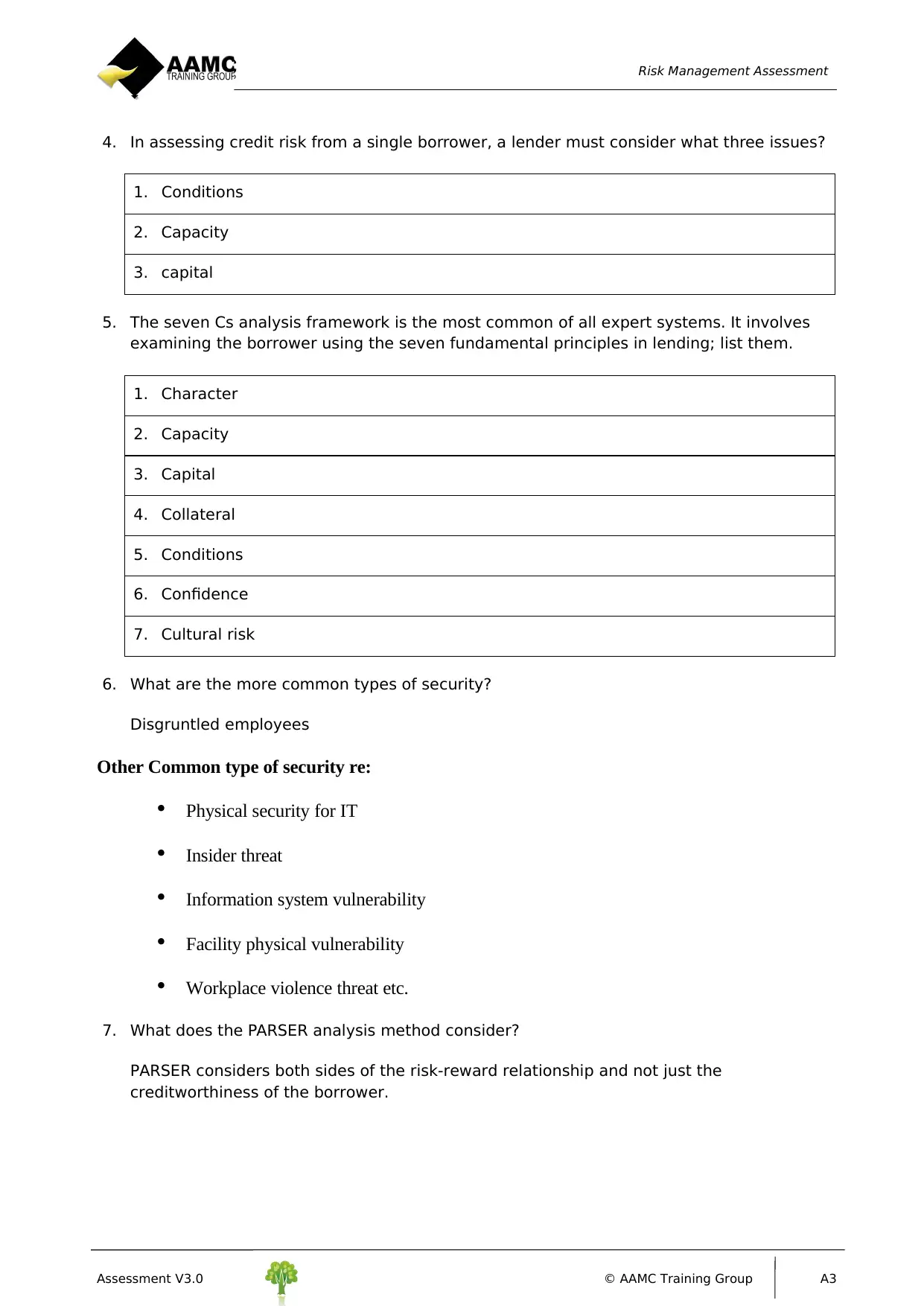
Risk Management Assessment
4. In assessing credit risk from a single borrower, a lender must consider what three issues?
1. Conditions
2. Capacity
3. capital
5. The seven Cs analysis framework is the most common of all expert systems. It involves
examining the borrower using the seven fundamental principles in lending; list them.
1. Character
2. Capacity
3. Capital
4. Collateral
5. Conditions
6. Confidence
7. Cultural risk
6. What are the more common types of security?
Disgruntled employees
Other Common type of security re:
Physical security for IT
Insider threat
Information system vulnerability
Facility physical vulnerability
Workplace violence threat etc.
7. What does the PARSER analysis method consider?
PARSER considers both sides of the risk-reward relationship and not just the
creditworthiness of the borrower.
Assessment V3.0 © AAMC Training Group A3
4. In assessing credit risk from a single borrower, a lender must consider what three issues?
1. Conditions
2. Capacity
3. capital
5. The seven Cs analysis framework is the most common of all expert systems. It involves
examining the borrower using the seven fundamental principles in lending; list them.
1. Character
2. Capacity
3. Capital
4. Collateral
5. Conditions
6. Confidence
7. Cultural risk
6. What are the more common types of security?
Disgruntled employees
Other Common type of security re:
Physical security for IT
Insider threat
Information system vulnerability
Facility physical vulnerability
Workplace violence threat etc.
7. What does the PARSER analysis method consider?
PARSER considers both sides of the risk-reward relationship and not just the
creditworthiness of the borrower.
Assessment V3.0 © AAMC Training Group A3
⊘ This is a preview!⊘
Do you want full access?
Subscribe today to unlock all pages.

Trusted by 1+ million students worldwide
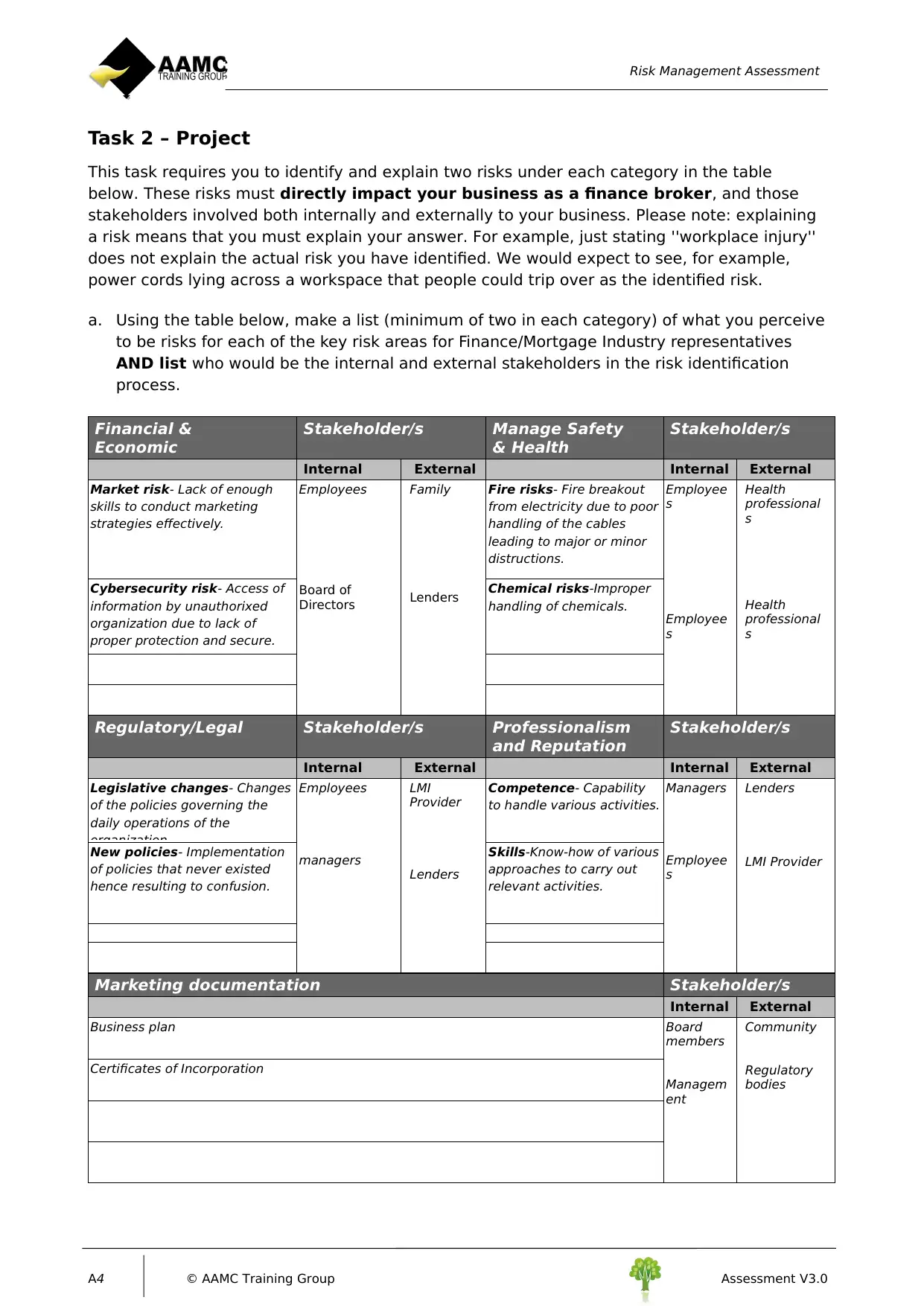
Risk Management Assessment
Task 2 – Project
This task requires you to identify and explain two risks under each category in the table
below. These risks must directly impact your business as a finance broker, and those
stakeholders involved both internally and externally to your business. Please note: explaining
a risk means that you must explain your answer. For example, just stating ''workplace injury''
does not explain the actual risk you have identified. We would expect to see, for example,
power cords lying across a workspace that people could trip over as the identified risk.
a. Using the table below, make a list (minimum of two in each category) of what you perceive
to be risks for each of the key risk areas for Finance/Mortgage Industry representatives
AND list who would be the internal and external stakeholders in the risk identification
process.
Financial &
Economic
Stakeholder/s Manage Safety
& Health
Stakeholder/s
Internal External Internal External
Market risk- Lack of enough
skills to conduct marketing
strategies effectively.
Employees
Board of
Directors
Family
Lenders
Fire risks- Fire breakout
from electricity due to poor
handling of the cables
leading to major or minor
distructions.
Employee
s
Employee
s
Health
professional
s
Health
professional
s
Cybersecurity risk- Access of
information by unauthorixed
organization due to lack of
proper protection and secure.
Chemical risks-Improper
handling of chemicals.
Regulatory/Legal Stakeholder/s Professionalism
and Reputation
Stakeholder/s
Internal External Internal External
Legislative changes- Changes
of the policies governing the
daily operations of the
organization.
Employees
managers
LMI
Provider
Lenders
Competence- Capability
to handle various activities.
Managers
Employee
s
Lenders
LMI Provider
New policies- Implementation
of policies that never existed
hence resulting to confusion.
Skills-Know-how of various
approaches to carry out
relevant activities.
Marketing documentation Stakeholder/s
Internal External
Business plan Board
members
Managem
ent
Community
Regulatory
bodies
Certificates of Incorporation
A4 © AAMC Training Group Assessment V3.0
Task 2 – Project
This task requires you to identify and explain two risks under each category in the table
below. These risks must directly impact your business as a finance broker, and those
stakeholders involved both internally and externally to your business. Please note: explaining
a risk means that you must explain your answer. For example, just stating ''workplace injury''
does not explain the actual risk you have identified. We would expect to see, for example,
power cords lying across a workspace that people could trip over as the identified risk.
a. Using the table below, make a list (minimum of two in each category) of what you perceive
to be risks for each of the key risk areas for Finance/Mortgage Industry representatives
AND list who would be the internal and external stakeholders in the risk identification
process.
Financial &
Economic
Stakeholder/s Manage Safety
& Health
Stakeholder/s
Internal External Internal External
Market risk- Lack of enough
skills to conduct marketing
strategies effectively.
Employees
Board of
Directors
Family
Lenders
Fire risks- Fire breakout
from electricity due to poor
handling of the cables
leading to major or minor
distructions.
Employee
s
Employee
s
Health
professional
s
Health
professional
s
Cybersecurity risk- Access of
information by unauthorixed
organization due to lack of
proper protection and secure.
Chemical risks-Improper
handling of chemicals.
Regulatory/Legal Stakeholder/s Professionalism
and Reputation
Stakeholder/s
Internal External Internal External
Legislative changes- Changes
of the policies governing the
daily operations of the
organization.
Employees
managers
LMI
Provider
Lenders
Competence- Capability
to handle various activities.
Managers
Employee
s
Lenders
LMI Provider
New policies- Implementation
of policies that never existed
hence resulting to confusion.
Skills-Know-how of various
approaches to carry out
relevant activities.
Marketing documentation Stakeholder/s
Internal External
Business plan Board
members
Managem
ent
Community
Regulatory
bodies
Certificates of Incorporation
A4 © AAMC Training Group Assessment V3.0
Paraphrase This Document
Need a fresh take? Get an instant paraphrase of this document with our AI Paraphraser

Risk Management Assessment
b. Once completed, provide a brief commentary on your understanding of the Australian
Standard AS/NZS ISO 31000:2009 Risk management — Principles and guidelines, i.e.,
definition and how it affects you as a Finance/Mortgage Industry representative.
ISO 31000:2009 has laid down policies that tend to help all industries. It is not specific on
what particular industry to work on. With these policies and guidelines, the firm will be able to
use the provided instructions to manage potential risks and threats facing the company.
Task 3 – Case study 1
You have an existing finance broking business which has grown over time. The business has
several key staff members including:
1 Responsible manager
1 Loan processor
3 Finance brokers
1 Personal assistant/office manager
1 Receptionist
You have been approached by a new client who is expanding his business operations into a
franchise opportunity and while he has not had his financials prepared by his accountant for
the last two years, he wants to use the family home as security and obtain a loan. The client
also informs you that he has a fair amount of cash available to assist in meeting the
repayments if required.
You are just about to meet him for the first time. Use the risk register below to identify and
describe three potential risks to your business and three potential risks to the client arising
from this proposal. Remember, when identifying risk, you need to consider both what can go
wrong and how it can go wrong.
Risk L C
Risk
rating
(LxC)
Comments
Your organization's risks
Default Risk 4 4 16 The borrower may default the process
incase he/she gets another alternative.
Governmental Risk 4 3 12 The government may ask to write off
the process.
Security Risk 3 3 9 The value of security offered may come
down.
Client risks
Choosing the Wrong Loan for the
Purpose
4 3 12 There is a possibility that ther client
may have decided poorly over the
loaning process.
Not Being Committed to Maintaining
(or Improving) Personal Credit
3 3 9 The client might fail to remain
commited to raise the required cash to
pay up the mortgage loan
Failure to reach to the agreement 3 3 9 Threre might be disagreement among
the parties hence leading to disapproval
of the process.
Assessment V3.0 © AAMC Training Group A5
b. Once completed, provide a brief commentary on your understanding of the Australian
Standard AS/NZS ISO 31000:2009 Risk management — Principles and guidelines, i.e.,
definition and how it affects you as a Finance/Mortgage Industry representative.
ISO 31000:2009 has laid down policies that tend to help all industries. It is not specific on
what particular industry to work on. With these policies and guidelines, the firm will be able to
use the provided instructions to manage potential risks and threats facing the company.
Task 3 – Case study 1
You have an existing finance broking business which has grown over time. The business has
several key staff members including:
1 Responsible manager
1 Loan processor
3 Finance brokers
1 Personal assistant/office manager
1 Receptionist
You have been approached by a new client who is expanding his business operations into a
franchise opportunity and while he has not had his financials prepared by his accountant for
the last two years, he wants to use the family home as security and obtain a loan. The client
also informs you that he has a fair amount of cash available to assist in meeting the
repayments if required.
You are just about to meet him for the first time. Use the risk register below to identify and
describe three potential risks to your business and three potential risks to the client arising
from this proposal. Remember, when identifying risk, you need to consider both what can go
wrong and how it can go wrong.
Risk L C
Risk
rating
(LxC)
Comments
Your organization's risks
Default Risk 4 4 16 The borrower may default the process
incase he/she gets another alternative.
Governmental Risk 4 3 12 The government may ask to write off
the process.
Security Risk 3 3 9 The value of security offered may come
down.
Client risks
Choosing the Wrong Loan for the
Purpose
4 3 12 There is a possibility that ther client
may have decided poorly over the
loaning process.
Not Being Committed to Maintaining
(or Improving) Personal Credit
3 3 9 The client might fail to remain
commited to raise the required cash to
pay up the mortgage loan
Failure to reach to the agreement 3 3 9 Threre might be disagreement among
the parties hence leading to disapproval
of the process.
Assessment V3.0 © AAMC Training Group A5

Risk Management Assessment
A6 © AAMC Training Group Assessment V3.0
A6 © AAMC Training Group Assessment V3.0
⊘ This is a preview!⊘
Do you want full access?
Subscribe today to unlock all pages.

Trusted by 1+ million students worldwide
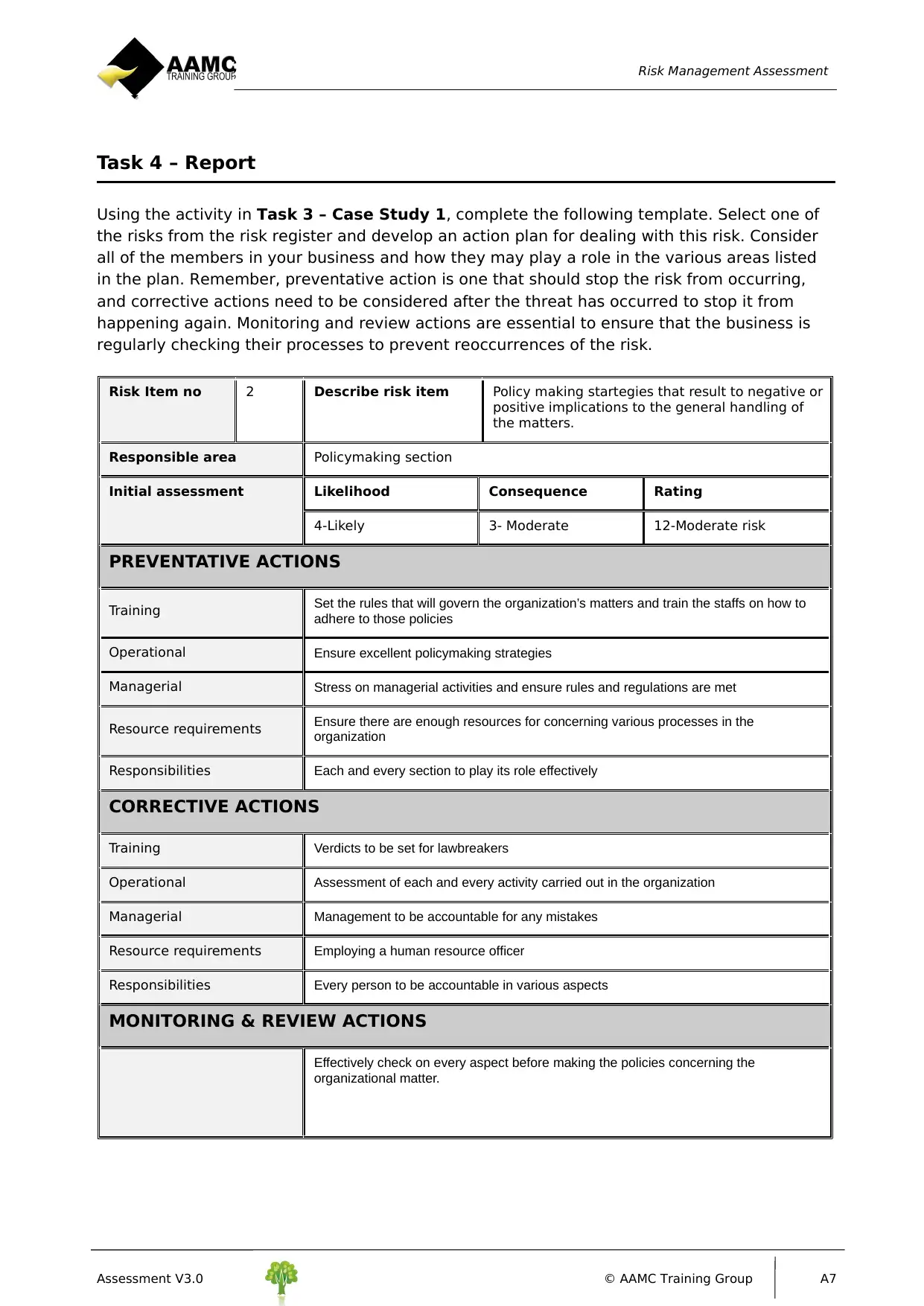
Risk Management Assessment
Task 4 – Report
Using the activity in Task 3 – Case Study 1, complete the following template. Select one of
the risks from the risk register and develop an action plan for dealing with this risk. Consider
all of the members in your business and how they may play a role in the various areas listed
in the plan. Remember, preventative action is one that should stop the risk from occurring,
and corrective actions need to be considered after the threat has occurred to stop it from
happening again. Monitoring and review actions are essential to ensure that the business is
regularly checking their processes to prevent reoccurrences of the risk.
Risk Item no 2 Describe risk item Policy making startegies that result to negative or
positive implications to the general handling of
the matters.
Responsible area Policymaking section
Initial assessment Likelihood Consequence Rating
4-Likely 3- Moderate 12-Moderate risk
PREVENTATIVE ACTIONS
Training Set the rules that will govern the organization’s matters and train the staffs on how to
adhere to those policies
Operational Ensure excellent policymaking strategies
Managerial Stress on managerial activities and ensure rules and regulations are met
Resource requirements Ensure there are enough resources for concerning various processes in the
organization
Responsibilities Each and every section to play its role effectively
CORRECTIVE ACTIONS
Training Verdicts to be set for lawbreakers
Operational Assessment of each and every activity carried out in the organization
Managerial Management to be accountable for any mistakes
Resource requirements Employing a human resource officer
Responsibilities Every person to be accountable in various aspects
MONITORING & REVIEW ACTIONS
Effectively check on every aspect before making the policies concerning the
organizational matter.
Assessment V3.0 © AAMC Training Group A7
Task 4 – Report
Using the activity in Task 3 – Case Study 1, complete the following template. Select one of
the risks from the risk register and develop an action plan for dealing with this risk. Consider
all of the members in your business and how they may play a role in the various areas listed
in the plan. Remember, preventative action is one that should stop the risk from occurring,
and corrective actions need to be considered after the threat has occurred to stop it from
happening again. Monitoring and review actions are essential to ensure that the business is
regularly checking their processes to prevent reoccurrences of the risk.
Risk Item no 2 Describe risk item Policy making startegies that result to negative or
positive implications to the general handling of
the matters.
Responsible area Policymaking section
Initial assessment Likelihood Consequence Rating
4-Likely 3- Moderate 12-Moderate risk
PREVENTATIVE ACTIONS
Training Set the rules that will govern the organization’s matters and train the staffs on how to
adhere to those policies
Operational Ensure excellent policymaking strategies
Managerial Stress on managerial activities and ensure rules and regulations are met
Resource requirements Ensure there are enough resources for concerning various processes in the
organization
Responsibilities Each and every section to play its role effectively
CORRECTIVE ACTIONS
Training Verdicts to be set for lawbreakers
Operational Assessment of each and every activity carried out in the organization
Managerial Management to be accountable for any mistakes
Resource requirements Employing a human resource officer
Responsibilities Every person to be accountable in various aspects
MONITORING & REVIEW ACTIONS
Effectively check on every aspect before making the policies concerning the
organizational matter.
Assessment V3.0 © AAMC Training Group A7
Paraphrase This Document
Need a fresh take? Get an instant paraphrase of this document with our AI Paraphraser
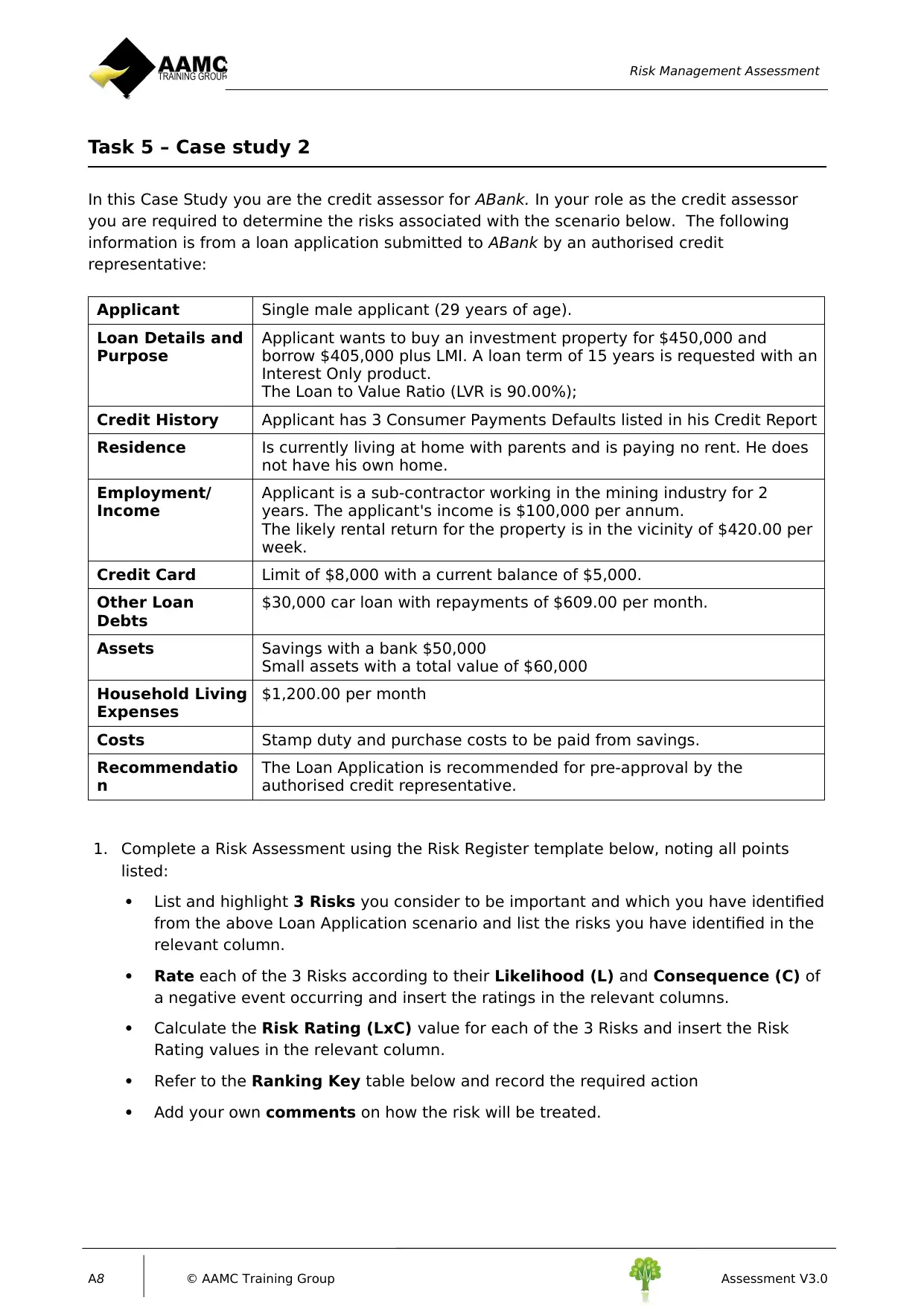
Risk Management Assessment
Task 5 – Case study 2
In this Case Study you are the credit assessor for ABank. In your role as the credit assessor
you are required to determine the risks associated with the scenario below. The following
information is from a loan application submitted to ABank by an authorised credit
representative:
Applicant Single male applicant (29 years of age).
Loan Details and
Purpose
Applicant wants to buy an investment property for $450,000 and
borrow $405,000 plus LMI. A loan term of 15 years is requested with an
Interest Only product.
The Loan to Value Ratio (LVR is 90.00%);
Credit History Applicant has 3 Consumer Payments Defaults listed in his Credit Report
Residence Is currently living at home with parents and is paying no rent. He does
not have his own home.
Employment/
Income
Applicant is a sub-contractor working in the mining industry for 2
years. The applicant's income is $100,000 per annum.
The likely rental return for the property is in the vicinity of $420.00 per
week.
Credit Card Limit of $8,000 with a current balance of $5,000.
Other Loan
Debts
$30,000 car loan with repayments of $609.00 per month.
Assets Savings with a bank $50,000
Small assets with a total value of $60,000
Household Living
Expenses
$1,200.00 per month
Costs Stamp duty and purchase costs to be paid from savings.
Recommendatio
n
The Loan Application is recommended for pre-approval by the
authorised credit representative.
1. Complete a Risk Assessment using the Risk Register template below, noting all points
listed:
List and highlight 3 Risks you consider to be important and which you have identified
from the above Loan Application scenario and list the risks you have identified in the
relevant column.
Rate each of the 3 Risks according to their Likelihood (L) and Consequence (C) of
a negative event occurring and insert the ratings in the relevant columns.
Calculate the Risk Rating (LxC) value for each of the 3 Risks and insert the Risk
Rating values in the relevant column.
Refer to the Ranking Key table below and record the required action
Add your own comments on how the risk will be treated.
A8 © AAMC Training Group Assessment V3.0
Task 5 – Case study 2
In this Case Study you are the credit assessor for ABank. In your role as the credit assessor
you are required to determine the risks associated with the scenario below. The following
information is from a loan application submitted to ABank by an authorised credit
representative:
Applicant Single male applicant (29 years of age).
Loan Details and
Purpose
Applicant wants to buy an investment property for $450,000 and
borrow $405,000 plus LMI. A loan term of 15 years is requested with an
Interest Only product.
The Loan to Value Ratio (LVR is 90.00%);
Credit History Applicant has 3 Consumer Payments Defaults listed in his Credit Report
Residence Is currently living at home with parents and is paying no rent. He does
not have his own home.
Employment/
Income
Applicant is a sub-contractor working in the mining industry for 2
years. The applicant's income is $100,000 per annum.
The likely rental return for the property is in the vicinity of $420.00 per
week.
Credit Card Limit of $8,000 with a current balance of $5,000.
Other Loan
Debts
$30,000 car loan with repayments of $609.00 per month.
Assets Savings with a bank $50,000
Small assets with a total value of $60,000
Household Living
Expenses
$1,200.00 per month
Costs Stamp duty and purchase costs to be paid from savings.
Recommendatio
n
The Loan Application is recommended for pre-approval by the
authorised credit representative.
1. Complete a Risk Assessment using the Risk Register template below, noting all points
listed:
List and highlight 3 Risks you consider to be important and which you have identified
from the above Loan Application scenario and list the risks you have identified in the
relevant column.
Rate each of the 3 Risks according to their Likelihood (L) and Consequence (C) of
a negative event occurring and insert the ratings in the relevant columns.
Calculate the Risk Rating (LxC) value for each of the 3 Risks and insert the Risk
Rating values in the relevant column.
Refer to the Ranking Key table below and record the required action
Add your own comments on how the risk will be treated.
A8 © AAMC Training Group Assessment V3.0
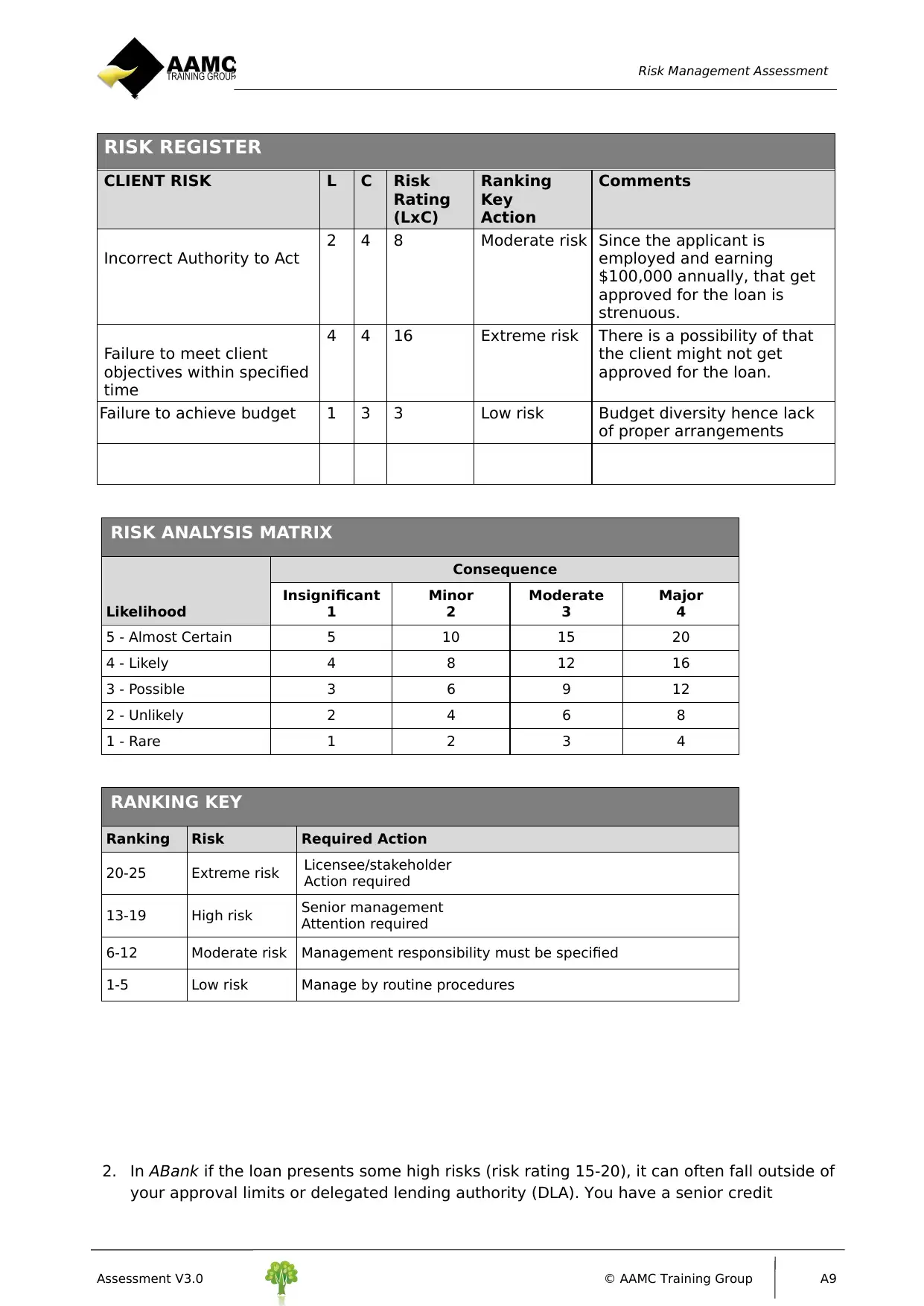
Risk Management Assessment
RISK REGISTER
CLIENT RISK L C Risk
Rating
(LxC)
Ranking
Key
Action
Comments
Incorrect Authority to Act
2 4 8 Moderate risk Since the applicant is
employed and earning
$100,000 annually, that get
approved for the loan is
strenuous.
Failure to meet client
objectives within specified
time
4 4 16 Extreme risk There is a possibility of that
the client might not get
approved for the loan.
Failure to achieve budget 1 3 3 Low risk Budget diversity hence lack
of proper arrangements
RISK ANALYSIS MATRIX
Likelihood
Consequence
Insignificant
1
Minor
2
Moderate
3
Major
4
5 - Almost Certain 5 10 15 20
4 - Likely 4 8 12 16
3 - Possible 3 6 9 12
2 - Unlikely 2 4 6 8
1 - Rare 1 2 3 4
RANKING KEY
Ranking Risk Required Action
20-25 Extreme risk Licensee/stakeholder
Action required
13-19 High risk Senior management
Attention required
6-12 Moderate risk Management responsibility must be specified
1-5 Low risk Manage by routine procedures
2. In ABank if the loan presents some high risks (risk rating 15-20), it can often fall outside of
your approval limits or delegated lending authority (DLA). You have a senior credit
Assessment V3.0 © AAMC Training Group A9
RISK REGISTER
CLIENT RISK L C Risk
Rating
(LxC)
Ranking
Key
Action
Comments
Incorrect Authority to Act
2 4 8 Moderate risk Since the applicant is
employed and earning
$100,000 annually, that get
approved for the loan is
strenuous.
Failure to meet client
objectives within specified
time
4 4 16 Extreme risk There is a possibility of that
the client might not get
approved for the loan.
Failure to achieve budget 1 3 3 Low risk Budget diversity hence lack
of proper arrangements
RISK ANALYSIS MATRIX
Likelihood
Consequence
Insignificant
1
Minor
2
Moderate
3
Major
4
5 - Almost Certain 5 10 15 20
4 - Likely 4 8 12 16
3 - Possible 3 6 9 12
2 - Unlikely 2 4 6 8
1 - Rare 1 2 3 4
RANKING KEY
Ranking Risk Required Action
20-25 Extreme risk Licensee/stakeholder
Action required
13-19 High risk Senior management
Attention required
6-12 Moderate risk Management responsibility must be specified
1-5 Low risk Manage by routine procedures
2. In ABank if the loan presents some high risks (risk rating 15-20), it can often fall outside of
your approval limits or delegated lending authority (DLA). You have a senior credit
Assessment V3.0 © AAMC Training Group A9
⊘ This is a preview!⊘
Do you want full access?
Subscribe today to unlock all pages.

Trusted by 1+ million students worldwide
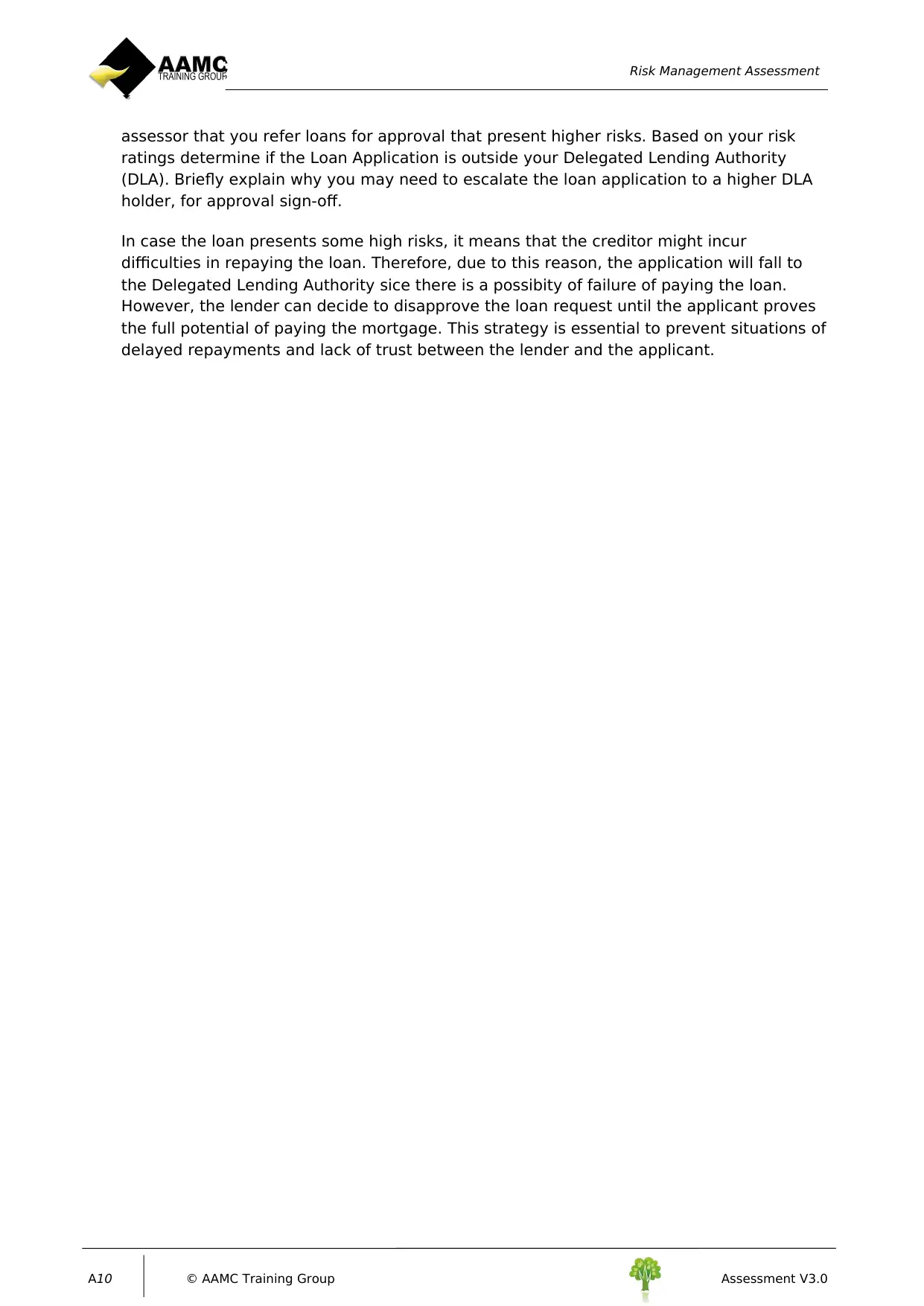
Risk Management Assessment
assessor that you refer loans for approval that present higher risks. Based on your risk
ratings determine if the Loan Application is outside your Delegated Lending Authority
(DLA). Briefly explain why you may need to escalate the loan application to a higher DLA
holder, for approval sign-off.
In case the loan presents some high risks, it means that the creditor might incur
difficulties in repaying the loan. Therefore, due to this reason, the application will fall to
the Delegated Lending Authority sice there is a possibity of failure of paying the loan.
However, the lender can decide to disapprove the loan request until the applicant proves
the full potential of paying the mortgage. This strategy is essential to prevent situations of
delayed repayments and lack of trust between the lender and the applicant.
A10 © AAMC Training Group Assessment V3.0
assessor that you refer loans for approval that present higher risks. Based on your risk
ratings determine if the Loan Application is outside your Delegated Lending Authority
(DLA). Briefly explain why you may need to escalate the loan application to a higher DLA
holder, for approval sign-off.
In case the loan presents some high risks, it means that the creditor might incur
difficulties in repaying the loan. Therefore, due to this reason, the application will fall to
the Delegated Lending Authority sice there is a possibity of failure of paying the loan.
However, the lender can decide to disapprove the loan request until the applicant proves
the full potential of paying the mortgage. This strategy is essential to prevent situations of
delayed repayments and lack of trust between the lender and the applicant.
A10 © AAMC Training Group Assessment V3.0
1 out of 10
Related Documents
Your All-in-One AI-Powered Toolkit for Academic Success.
+13062052269
info@desklib.com
Available 24*7 on WhatsApp / Email
![[object Object]](/_next/static/media/star-bottom.7253800d.svg)
Unlock your academic potential
Copyright © 2020–2025 A2Z Services. All Rights Reserved. Developed and managed by ZUCOL.




